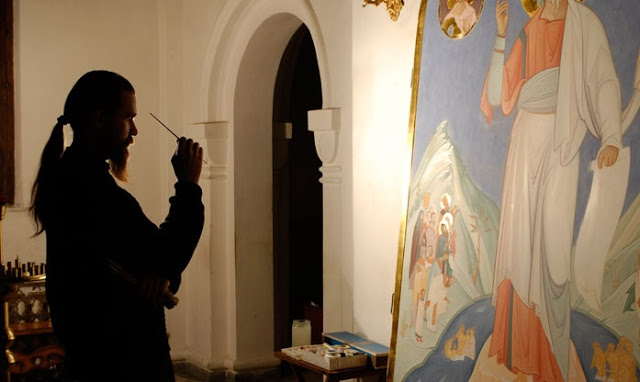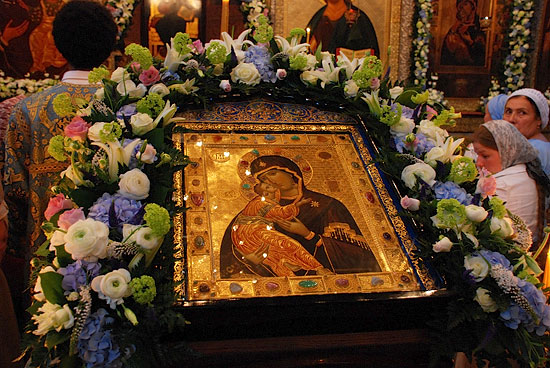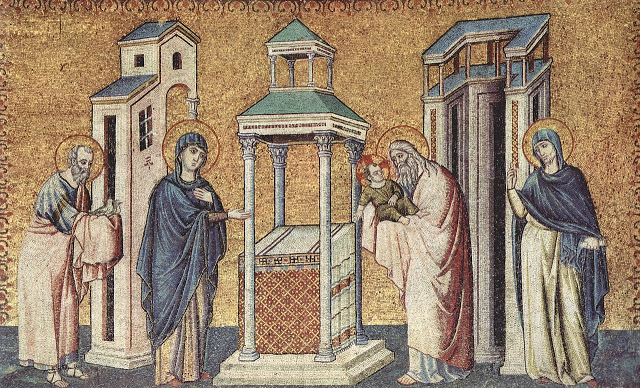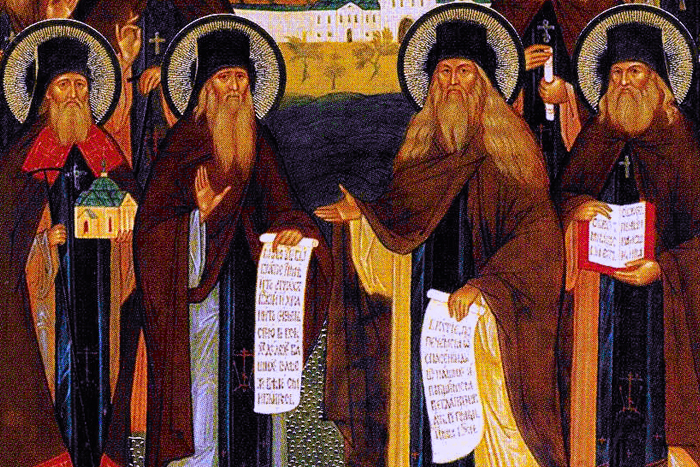This post has 0 reviews.

Father Sergius Nezhbort, head of the icon-painting workshop of St. Elisabeth Convent: “The icon is born through prayer of many people”.
How did you become an icon-painter?
It is hard to say how I became an icon-painter and whether I became one at all. First, I had a dream. It turned out that when I came to the Church, the Lord revealed Himself to me through the icon. This event changed everything in my life: I started attending church, I was baptized, and the icon became a window into the Heavenly Kingdom for me. At that time I wanted to believe that I would be painting icons one day. I was just an artist then. I studied in a school of art. I dreamt of painting icons but time flied, and life was going on and on, and one day I realized that it was not possible, as I had neither an opportunity, nor a person who would teach me. I forgot about my dream for a while. Five years passed, and this dream came true one day. It happened so that I had an opportunity to get involved in icon-painting. This has become an integral part of my life. However, it is far too daring to call myself an icon-painter.
The History of the Workshop
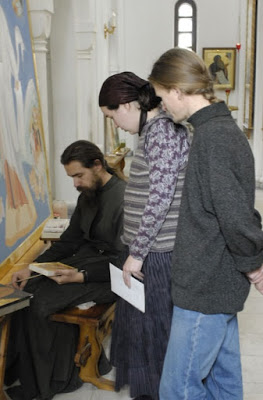 Larisa Nezhbort, nun Ludmila (Leiko) and I were blessed by Fr Andrew Lemeshonok to work in the icon-painting workshop in spring 1999. Each one of us had their own way to the icon. At that time there was daring and great desire to do that but we were not skilled to paint icons and we had practically nothing to start with. We were doing our best. Gradually, year by year, new people kept coming… and the workshop grew steadily. Much has changed since then. At that time, we did not know the most basic principles: how to gild an icon and how to rub up colors. Our first icons were like sand paper because we were bad at rubbing up the pigments. Now everything is different. Then we had little materials and we had no opportunity to work with good samples. There were a couple of books and albums from home libraries, and this was not enough, of course. I reviewed our old photos several days ago, and I was ashamed when I saw what we were making at that time. Probably, this was a certain stage of our development and we had to go through it. Now there is another stage. When new people come in our workshop willing to paint icons, they can have answers to their questions from our own experience. Skills we had to acquire for years (painting, gilding, using a sample), can be used by the students after a month of learning.
Larisa Nezhbort, nun Ludmila (Leiko) and I were blessed by Fr Andrew Lemeshonok to work in the icon-painting workshop in spring 1999. Each one of us had their own way to the icon. At that time there was daring and great desire to do that but we were not skilled to paint icons and we had practically nothing to start with. We were doing our best. Gradually, year by year, new people kept coming… and the workshop grew steadily. Much has changed since then. At that time, we did not know the most basic principles: how to gild an icon and how to rub up colors. Our first icons were like sand paper because we were bad at rubbing up the pigments. Now everything is different. Then we had little materials and we had no opportunity to work with good samples. There were a couple of books and albums from home libraries, and this was not enough, of course. I reviewed our old photos several days ago, and I was ashamed when I saw what we were making at that time. Probably, this was a certain stage of our development and we had to go through it. Now there is another stage. When new people come in our workshop willing to paint icons, they can have answers to their questions from our own experience. Skills we had to acquire for years (painting, gilding, using a sample), can be used by the students after a month of learning.Who taught you to paint icons?
Our first steps were assisted by Archpriest Igor Latushko. We all knew him and asked him questions concerning the substance side of the icon in the first place. For example, he could clearly explain why a certain saint must be painted exactly that way, and what was the meaning and the symbolism of a festive icon. It was vital for us at that time because we all had just artistic education. Personally, I had a very important experience in my life when I helped the icon-painter Andrew Kosikov. Working in his workshop as an apprentice, I saw the inner side of an icon-painter’s work and understood how hard it was. I did not know much at that time but I could gesso the boards, I could wash a palette or the floor…
I was very pleased to take part in all this. Now when I paint icons myself I can see that it would be more difficult for me if I did not have such experience. These two people helped me a lot in the very beginning. We do not have certain teachers, though. We learned from each other most likely. We learned from books, we learned by studying icon-painter’s samples carefully, we learned from prayer and faith. We traveled to Fr Zinon several times but I cannot say he was our teacher. He was always very hospitable to us and that was important for us at that moment. Well, and surely, when you see the icons of this master, when you see him at work, you can understand a lot.
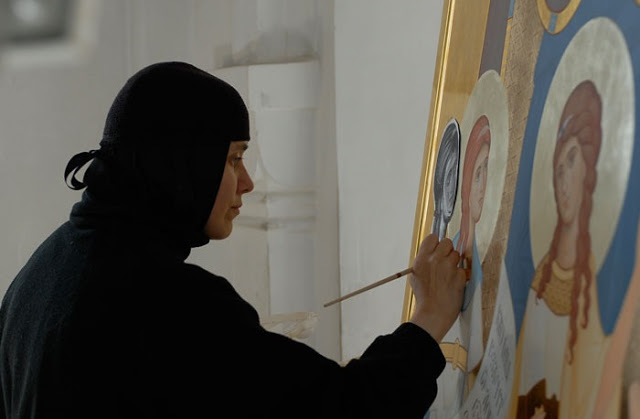
How do you paint an icon?
Like a human, an icon maybe has the body, the soul and the spirit. It is always difficult to speak about the spiritual side of the matter. It is easier to speak from the craftsman’s point of view. An icon is painted in a traditional way. From the very beginning we decided that we would paint traditional icons, without using new technologies, modern colors or primers. We try to paint icons as they were painted in ancient times. We paint them on a lime or pine board with a nitch. The board is primed in a special way. The priming consists of chalk and glue, it is applied in several coats and gives a flat and smooth surface. The pigments we use are prepared from minerals, even semiprecious stones are used (such as lazurite and malachite).
An icon is painted following a sample. Looking at the sample, an icon-painter traces the lines of the icon first, then the background or the halo is covered with gold leaf, and the icon-painter continues his work. Garments and buildings are painted first, and then we paint the faces. The icon is covered with varnish in the very end. These are the main steps but everybody has a different approach toward them. As a rule, the soul of the person and his inner life are somehow reflected in his work. An icon is a spiritual barometer in a sense, since it shows the inner state of the icon-painter. While an artist expresses himself through his work and admires it at a picture, one looks at an icon as a mirror where one can see all his untruth. This exposes the sins of the icon-painter and can be pressing sometimes. The difficulty and the problem with the icon-painter’s ministry is that although you can see that you are not ready to paint icons, you still have to go on painting. The Lord helps through icons. A person who faces his inner untruth begins searching for God even more so that he could change and live according to the Lord’s truth.
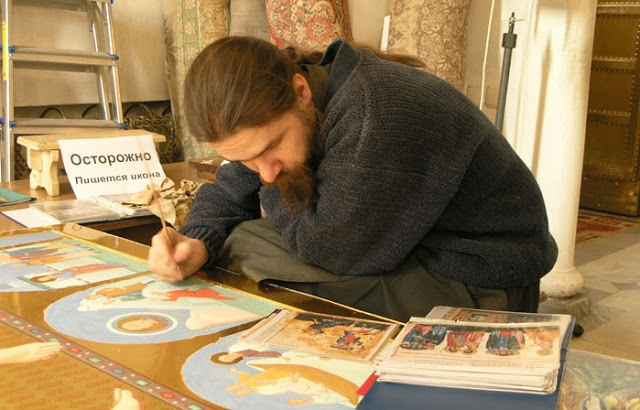
On attitude to printed icons
What is my attitude? I venerate them. An icon is an icon whatever method of production: painted using pigments or printed using a printing press. If the icon complies with the rules and is consecrated, it is an icon anyway. Sometimes printed icons do not correspond to artistic tastes, but tastes differ, you know. Praise the Lord that every person has an opportunity to have an icon in his house because if the icons were painted only, not everybody could afford them, for it is expensive. On the other hand, there is a negative side to it because people really appreciated any image in ancient times because not every one can paint an icon. Everything that is painstaking to produce is more precious. There are lots of printed icons today, and people lose the awe before a sacred image, unfortunately.
Traditions that influenced the painting style
It is very hard to tell what traditions had an influence on us. At first, we based on Ancient Russian samples, the icons of Andrew Rublev and Dionisius were the benchmarks for us. Now we have a lot of opportunities: there are sources on Byzantine icons, and we can get to know the samples of 6th century iconography. Thus, an icon-painter has a wide diversity to choose from. That is why we do not have a clear-cut tendency. However, the work of certain icon-painters sets the mainstream of the work for the others. We also look at the modern samples, for example, at the works of Holy Trinity-St Sergius Lavra icon-painters and we try to stick to the mainstream of the modern icon-painting.
On creativity in painting icons
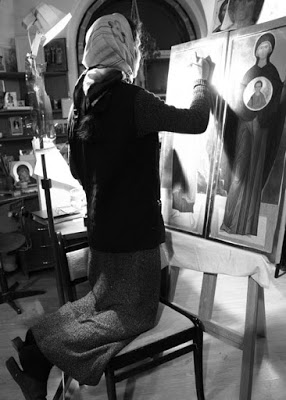
This is a sophisticated question. What is creativity and what is a canon? Each person has his own answers to these questions. Canon is a Greek word meaning a straight stick, that is, it defines an upright measure. The canon is not a set of regulations; it is the language of the Church. One can view the canon as a rigid pattern, but creativity can be also eerie. The Lord inspired creative life into everybody. The human is created according to the image of God the Creator. A meeting of God and man happens in an icon. There is man and there is the Lord, and an icon-painter bears witness to this meeting when he paints an icon. Thus a true icon is created, for example, the icon of the Holy Trinity by Andrew Rublev. This is visibly not a human invention (daydreaming) but the highest of the arts. This is what turns into a canon. The canon is not derived from dry theoretical data. It appears where God and man meet one another and perhaps, the people who are near suddenly see that this is something they may and should follow. That is how the canon appears. It is wrong to speak of the canon as of a stable pattern. The icons of new saints have to be painted now. There are no canonical images of these saints; there are photos so an icon-painter should have a creative approach. Generally, the Church is alive, and the life cannot stop dead in its tracks.
On students
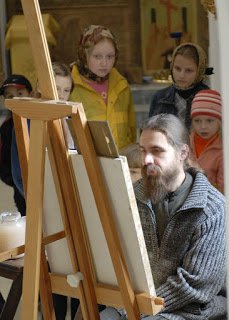 People who would like to become icon-painters keep coming. Some come and then go, some remain. It is life. How does a tree grow? Some branches blossom and some wither. The same holds true for our workshop as well. There are people who seek for an opportunity to serve God through the icon. So we attempt to share our experience. It is far too early to call it a “teacher-student” relationship. We just try to share something we have learned or felt.
People who would like to become icon-painters keep coming. Some come and then go, some remain. It is life. How does a tree grow? Some branches blossom and some wither. The same holds true for our workshop as well. There are people who seek for an opportunity to serve God through the icon. So we attempt to share our experience. It is far too early to call it a “teacher-student” relationship. We just try to share something we have learned or felt.Is there a difference between an artist and an icon-painter?
It depends on the personality of the artist or the icon-painter. Pablo Picasso and Andrew Rublev are different although both have some peculiarities that are impossible to compare. Not every artist should be an icon-painter. This is because an icon-painter is a person who serves God in the first place. Icon painting is a church obedience. There are various obediences in the Church: choir singing, reading, tidying up the church. All these obediences are indispensable so it is impossible to say that one is better and the other is worse. Same with an artist and an icon-painter.
An icon-painter is indispensable because icons are to be painted for the new churches that are built; and an artist is indispensable because people look for the beauty and this beauty does not necessarily have to be of religious background. Every artist feels God, perhaps, even in the outward beauty: in nature, in people and in relations. That is why I think there is no conflict between an artist and an iconographer; it is that their tasks differ. An icon-painter has a more particular speciality. Generally, an artist…I think that every person is an artist in a sense. And it is impossible to clearly separate one from another.
What icons are painted most often?
The icon painted most often is the icon of our Saviour. This is the main icon and most people want to have the icons of the Savior and the Mother of God in their homes. Many people also order an icon of their heavenly patrons.
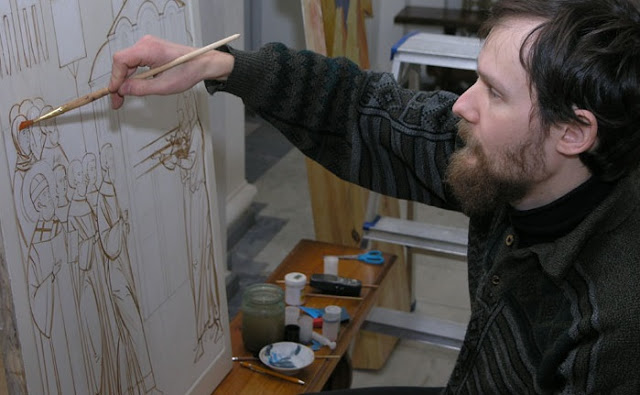
Is painting icons a catholic art?
Sure. Look at it from the technical side of the matter: one person makes the board, another covers it with gesso, a third gilds it and a fourth paints on it. Only if they cooperate and unite their efforts, an icon can appear. An icon-painter must understand that everything he does is the reflection of the prayer of the whole Church. The more people seek for God, the easier it is for us to paint an icon. Looking back into history, the 15th century is the Golden Age of icon-painting. There was spiritual revival at that time but when it faded the icon-painters faced more difficulties as they worked. The late 20th and the early 21st centuries, judging from the fact that many icon-painting workshops have come into existence, is the time of spiritual revival. Fr Igor often says that an icon-painter reflects the today’s state of the humankind. It is important that people who come to church and look at the icons would understand that this is not a one-person work. An icon comes in existence as a result of prayer of many people.

